Track Design
Tribute Site |
|
|
|
|
|
|
| Table Size |
|
The first decision you will need to make is the overall size of your HO slot car track table. While a challenging racing circuit can easily be built on a table as small as 36" x 80" most racers build a larger layout. Common sizes are 4x8 or 5x9 foot tables. These will normally provide enough room for a variety of turn radius sizes and several fast straights. Tables of this size can be constructed from standard-sized sheets of plywood. |
|
|
|
|
| 2-Lane vs. 4-Lane |
|
Once you have decided upon the size of the table that you wish to build you will need to consider how many lanes your race track will have. Most home racers build race tracks with either 2 or 4 lanes. |
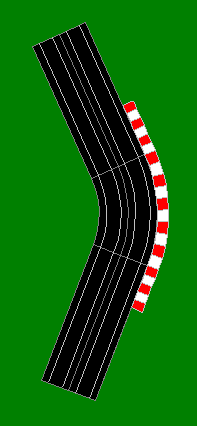
|
|
|
|
|
|
|
| Track Configuration |
|
After choosing the table size and lane width of your race track you will want to consider the actual layout configuration. HO slot car tracks fall into two main categories; flat raceways and race tracks that employ an overpass, or over-and-under configuration, similar to the classic figure "8". |
|
|
|
|
| Landscaping |
|
One more thing that you will want to consider early on in the design phase is whether or not you will be building a landscaped layout. A landscaped layout adds a certain realism to your racing. Landscaped layouts will normally require more green space between the different sections of your track though, so if you plan to landscape your layout in the future leave a little extra room between track sections to accommodate your landscaping and track-side buildings. |
|
|
|
|
| Circuit Elements |
|
The secret to a successfully designed HO scale race track is course variety. A variety of different types of corners, several long, fast straights, mixed with a few connecting chutes to join them all together will provide an interesting and challenging race track that will test both a driver's skill and ability to prepare a well handling HO slot car. |
|
|
|
|
| Hairpin Turns |
|
The first corner style listed here is the Hairpin turn. Almost every road racing course and sportscar track has at least one of these. A hairpin turn is often found at the end of a long straight, forcing a driver to slow drastically after a long high speed run. |

|
|
|
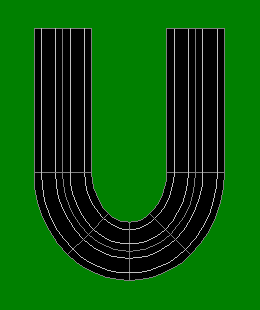
|
|
|
|
|
|
|
| Parabolic Turns |
|
The next corner type is the Parabolic turn. Parabolic turns come in two varieties; increasing radius and decreasing radius corners. In the illustration below, if the cars were to enter from the left side each turn section they encounter would have an increasing or wider radius. On the other hand, if the cars were to enter from the right side each turn section decreases or tightens. |
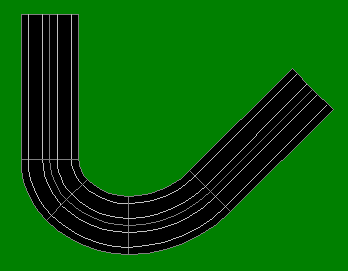
|
|
|
|
|
|
|
| Carousel Turns |
|
The next type of turn is the Carousel. This type of corner is usually a constant radius turn comprised of the largest turn radius sizes available. The 4-lane example below uses 15" and 18" radius turns for all sections of the corner. In the illustration below cars would enter from the left side and exit at the right. |
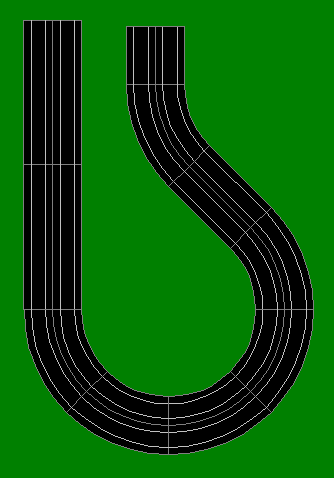
|
|
|
|
|
|
|
| Sweeping Turns |
|
The Sweeping turn, or sweeper as it's often called, is a nice alternative to the standard 90 degree curve. By placing a short straight section between two 45 degree turn sections you can create a turn that is much more interesting and challenging to drive than a standard 90 degree left or right hander. |

|
|
|
|
|
|
|
| Kinks |
|
The Kink is a gentle bend placed somewhere in the middle of a long straight. A kink forces a driver to lift slightly and then get right back on the power. This type of turn, while deceptively simple can test a driver's skill. Eau Rouge at Spa-Francorchamps is a classic example of a fast kink. |

|
|
|
|
|
|
|
| 180° Turns |
|
The 180° Turn is normally a constant radius curve that joins two fast straights. Cars brake well before the entry and then accelerate through the turn to the exit, but unlike the hairpin turn described earlier, this turn employs larger radius curve sections to allow cars to negotiate it at a much higher rate of speed. 15" and 18" radius turn sections are recommended for this type of corner. |
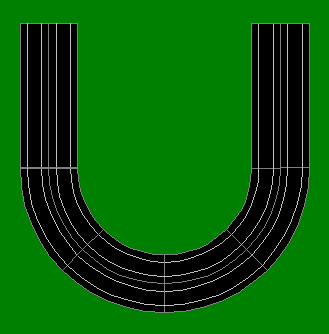
|
|
|
|
|
|
|
| Chicanes |
|
A Chicane is normally inserted into a fast straight to slow cars down. Chicane sections have become popular in recent years on real-world race tracks as a safety device to slow ever-faster race car designs. |
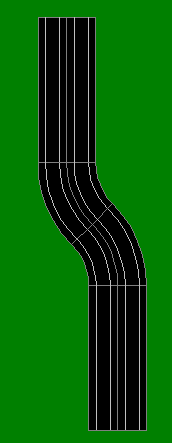
|
|
|
|
|
|
|
| Esses |
|
Classic Esses can be found on almost all of the worlds best known race tracks and road courses. This turn's name comes from its "S" shape. Esses, like the chicane mentioned above require heavy braking prior to the entry. Esses work to slow a car down much more though than a simple chicane. |
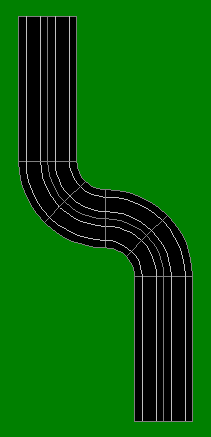
|
|
|
|
|
|
|
| Washboard Turns |
|
The Washboard turn is found on many commercial HO slot car tracks. Racers either love or hate this type of turn. While offering no real-world context they can be found in many HO slot car track designs. Purists normally avoid this type of turn configuration. Esses or Chicanes are usually a better choice, but it is included here because some racers find it interesting. |

|
|
|
|
|
|
|
| Bus Stop Turns |
|
The next corner style listed here is actually a series of turns combined to create a distinct course element. Its name comes from the Bus Stop turn at Belgium's Spa-Francorchamps. |
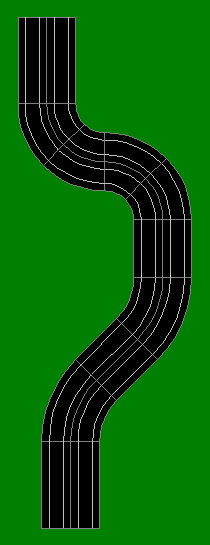
|
|
|
|
|
|
|
| Banked Turns |
|
The last corner style listed here is a Banked Turn. Banked turns allow a car to travel much faster than they normally would through a flat turn. Banked turns work best when placed before a long straight. This arrangement allows the cars to exit the banked section at a higher rate of speed, and consequently travel down a long straight faster than they would if they exited a flat turn. |
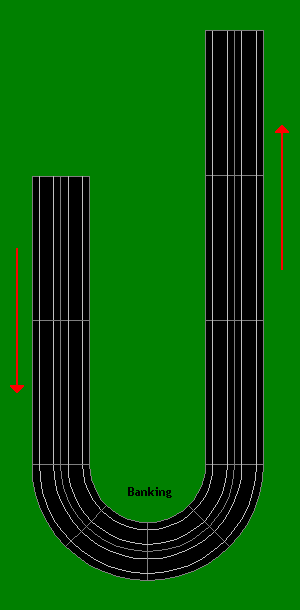
|
|
|
|
|
|
|
| Putting It All Together |
|
The race track below illustrates several types of turns combined to make a challenging racing circuit. This layout fits on a single 5x9 foot table and provides a lap length of just over 50 feet per lane. This layout uses 12" and 15" radius turns whenever possible. |

|
|
|
|
Here's an inventory of the Tomy AFX track sections required to build this layout: |
|
|
|
See the Borders section of this web site for detailed instructions on fabricating your own track FIA borders. |
|
|
|
|
| Designing Your Track |
|
Several track design methods are available. The easiest way to design a track though is to use slot car track design software. Design software allows you to try numerous configurations until you have a track you really like. |